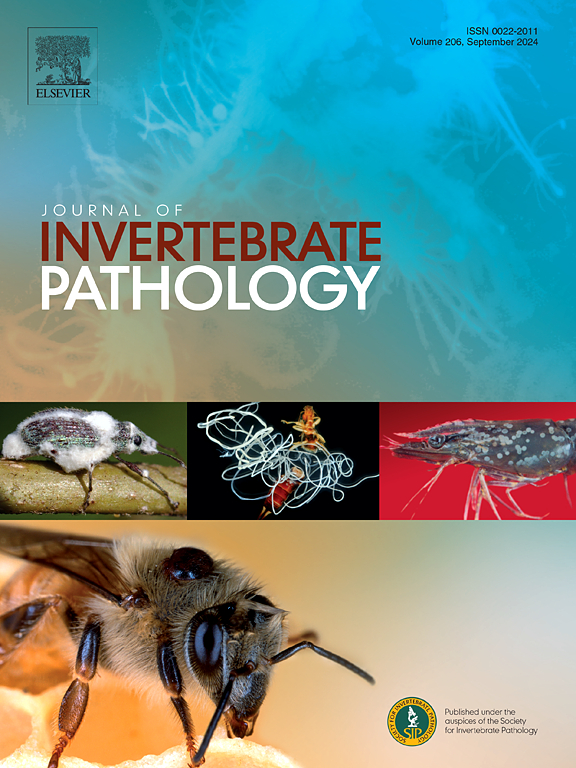First report of a xenoma-forming parasitic ciliate in a gastropod: The case of the invasive snail Pomacea canaliculata
IF 3.6
3区 生物学
Q1 ZOOLOGY
引用次数: 0
Abstract
The apple snail Pomacea canaliculata is native to South America and has been introduced into many regions outside its natural range. Despite being one of the world’s 100 worst invasive species, little is known about the pathologies caused by parasites other than digeneans. Here, we identify and characterize a xenoma-forming ciliate in P. canaliculata from three waterbodies in the province of Buenos Aires, Argentina, using histology, transmission electron microscopy (TEM), and molecular analyses. Under a stereomicroscope, the xenomas appeared individually as white nodules measuring up to 2 mm in diameter. Of the 133 snails examined by histology, 23 were infected with xenomas (17 %) that occupied the connective tissue of most organs, with 74 % of these were located in the kidney. Snails from the three water bodies were infected. The highest prevalence was observed in the Mar del Plata Port Reserve Pond (25 %), followed by Los Padres Lake (16.4 %) and Pigüé-Venado Channel (14.4 %). Of the infected snails, 70 % had a low infection intensity (fewer than 10 xenomas per slide). No significant inflammatory response was observed in host tissues. However, in specimens with xenoma accumulations, significant tissue changes were observed, including organ enlargement in the gill lamellae, mantle border, and lung, as well as tubule compression and connective tissue replacement in the digestive gland. The host cell becomes hypertrophied, and its nucleus disintegrates. Although no cilia were observed in histological sections, TEM analysis revealed that the organisms had cilia near the cytostome and around the body, a large food vacuole, a macronucleus, and a micronucleus. Phylogenetic analysis of the SSU rDNA sequence placed the ciliate in the class Phyllopharyngea, showing the closest relationship to an uncultured eukaryote identified by BLAST. This is the fifth record of xenoma-inducing ciliates in mollusks and the first report in a gastropod.

腹足动物中形成异种瘤的寄生纤毛虫的首次报道:入侵蜗牛小管螺的案例
苹果蜗牛Pomacea canaliculata原产于南美洲,并已被引入其自然范围以外的许多地区。尽管是世界上100种最严重的入侵物种之一,但人们对除digenian外的寄生虫引起的病理知之甚少。在这里,我们用组织学、透射电子显微镜(TEM)和分子分析鉴定和表征了阿根廷布宜诺斯艾利斯省三个水体中P. canaliculata中形成异种瘤的纤毛虫。在体视显微镜下,单个异种瘤表现为白色结节,直径可达2mm。在组织学检查的133只蜗牛中,23只感染了占据大多数器官结缔组织的异种瘤(17%),其中74%位于肾脏。来自三个水体的蜗牛被感染。马德普拉塔港储备池患病率最高(25%),其次是Los Padres湖(16.4%)和pig - venado海峡(14.4%)。在受感染的蜗牛中,70%的感染强度较低(每张幻灯片少于10个异种瘤)。在宿主组织中未观察到明显的炎症反应。然而,在异种瘤聚集的标本中,观察到明显的组织变化,包括鳃片、套缘和肺的器官肿大,以及消化腺的小管压迫和结缔组织替换。宿主细胞变得肥大,细胞核解体。虽然在组织学切片上没有观察到纤毛,但TEM分析显示,这些生物在细胞壁附近和身体周围有纤毛,有一个大的食物液泡,一个大核和一个微核。系统发育分析表明,该纤毛虫属于phyllophyngea纲,与BLAST鉴定的非培养真核生物亲缘关系最近。这是在软体动物中第五次记录到诱发异种瘤的纤毛虫,也是在腹足动物中首次报道。
本文章由计算机程序翻译,如有差异,请以英文原文为准。
求助全文
约1分钟内获得全文
求助全文
来源期刊
CiteScore
6.10
自引率
5.90%
发文量
94
审稿时长
1 months
期刊介绍:
The Journal of Invertebrate Pathology presents original research articles and notes on the induction and pathogenesis of diseases of invertebrates, including the suppression of diseases in beneficial species, and the use of diseases in controlling undesirable species. In addition, the journal publishes the results of physiological, morphological, genetic, immunological and ecological studies as related to the etiologic agents of diseases of invertebrates.
The Journal of Invertebrate Pathology is the adopted journal of the Society for Invertebrate Pathology, and is available to SIP members at a special reduced price.

 求助内容:
求助内容: 应助结果提醒方式:
应助结果提醒方式:


